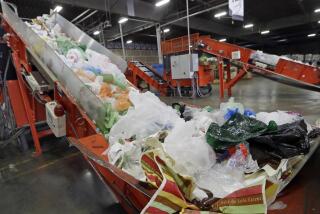Most Common Beach Trash Is Plastic Pellets
- Share via
In case you wondered, there were 43,167 fast-food containers lying on Orange County beaches in the fall of 1998. And 1,003 diapers.
But the first comprehensive study of beach trash in Orange County found that the most common debris is neither those items, nor cigarette butts, nor paper wrappers, but tiny plastic pellets.
The study, which derived its figures from sampling, concluded that an estimated 105 million of the pellets were found along the sandy beaches and rocky areas along the county’s coast, making up most of the nearly 107 million pieces of trash littering the county’s shore. The study was released Thursday by a 30-year-old coalition of government agencies called the Southern California Coastal Water Research Project.
Only 5 millimeters in diameter, the pellets are commonly found buried in the sand, barely noticeable to beach-goers. Spilled from freighters off Southern California and around the world, they are used by manufacturers who mold them into everything from children’s toys to car parts. They pose a hazard to birds that mistake the pellets for food and then die from a lack of nutrients, said marine biologist Shelly Moore, author of the report.
The abundance of the pellets comes as a surprise to researchers, who know little about beach trash. Although studies like this are being mounted across the globe, few are performed in the United States, and scientists hope the results will finally force people to take notice of the problem.
“We were surprised about the number of plastic pellets. I’ve lived in Southern California all my life and didn’t even know they were there,” Moore said. “This will tell the public that what they throw on the ground or storm drains does make it to the beaches and oceans.”
To conduct the study, researchers combed sections of beach selected at random in August and September 1998 and took debris back to the laboratory for analysis. Estimates for trash totals were then made from the sample results.
The study, painstaking in its detail, lists everything from fishing line to food wrappers, and even categorizes many by brand. Starburst was the most common candy litter, while Marlboros made up 62% of all cigarette trash, the study found.
Researchers said these statistics do not suggest any fault on the part of the makers. But the study did find a surprising number of Jack-in-the-Box wrappers--27% of the total, far higher than the restaurant’s local market share. Scientists could not explain why but are planning further research.
Following plastic pellets, the second and third most common types of trash found on Orange County beaches were foam plastics and hard plastics, at nearly 750,000 and 650,000 items respectively. Next came cigarette butts--312 pounds of them--and paper.
Previous attempts at counting the trash on California Coastal Cleanup Day in 1998 found only about 32,000 total pieces on local shores. This, researchers say, is because the cleanup workers found larger, more visible items such as glass bottles and aluminum cans and focused upon trash removal, rather than determining the amount of trash on the shore.
Now that researchers know how much trash is out there, they hope the public understands the consequences.
“Our beaches are at risk, and if we’re not careful, we’ll find ourselves in a situation where we can’t use them any more,” said Chris Evans, executive director of San Clemente-based Surfrider Foundation, a national group that protects the oceans. “Fortunately, these are problems we can solve. This is about all of us cleaning up our act and being better stewards of the environment.”
*
Garry Brown of Orange County CoastKeeper hopes the results spark government action internationally and locally. Already, he said, Newport Beach is planning to clean up its shores in response to the report.
“The unfortunate thing is that the pellets could be dropped anywhere, in international waters or near the shore,” Brown said. “Eventually, the whole thing comes down to the habits of industry and citizens.”






